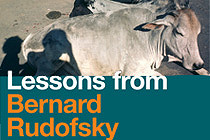
|
Lessons from Bernard Rudofsky A cooperation by the Architekturzentrum Wien with The Getty Research Institute, Los Angeles in association with the Canadian Centre for Architecture, Montreal "The excellent exhibition 'Lessons from Bernard Rudofsky' at the Az W is dedicated to the myth Rudofsky. ...a wonderful survey." Falter, March 2007, Nr. 12 "The way that the architect captures his impressions of the world in watercolours, photographs and notebooks enables this survey and its truly excellent catalogue to provide an immediate experience of the oeuvre of this multi-visionary." Neue Zürcher Zeitung, 10 March 2007 PRESS RELEASE Press conference: Wednesday 07.03.2007, 11am Opening: Wednesday 07.03.2007, 7pm Bernard Rudofsky (1905 – 1988) planned a large number of exhibitions during his widely travelled and cosmopolitan life, these included: Are Clothes Modern? (1944), Textiles USA (1956), The Unfashionable Human Body (1971), Now I Lay Me Down To Eat (1980), Sparta/Sybaris (1987). The most well known and the most influential of these exhibitions was Architecture without Architects (1964), which toured for eleven years and showed at over 80 different venues around the world. Despite this, there has never been an exhibition about him and his work. This exhibition is the first in the world dedicated to the life and oeuvre of this unique pioneer of modern architecture, however it has not been conceived as a classical retrospective. The aim is to make the cosmopolitan Rudofsky's complex architectural concept and concept of how to live accessible to a broad public, while addressing his relevance today. Bernard Rudofsky was neither an architect nor a theorist in the usual sense. At the start of his career he completed a number of houses in Italy and Brazil, where he employed the formal language of the Modernists although his writings appear to indicate that Rudofsky was primarily engaged as a critic and culture theorist from the 1940s. He did not just write about architecture and design, but also on topics such as clothing, shoes, eating and bathing. The common element behind all of these activities, though, was the human body, and his lamentation of the loss of sensual awareness. No lifestyle should be preformed, preordained or preconceived. The interaction of the human being with the environment he has shaped has to be characterised by an individual attitude towards the life of a responsible citizen. With this approach Rudofsky leads both forwards and backwards in time in his study of our real rudimentary needs. The exhibition Lessons from Bernard Rudofsky covers the span from Rudofsky's cultural roots in the beginnings of European Modernism to his enigmatic influence on the international architecture discourse and the many journeys he undertook in his life between these. Rudofsky saw travel as a way of acquiring knowledge, and he collected, reflected on and documented his impressions with an unfailing passion. This comprehensive show on Bernard Rudofsky provides detailed information on his life, his travels, his various activities as an architect, designer, exhibition-maker, author and theorist, as well as about the life he shared with his wife, Berta Rudofsky. The catalogue of the exhibition Lessons from Bernard Rudofsky, with contributions by Andrea Bocco-Guarneri, Monika Platzer, Felicity Scott, Wim de Wit, Maria Welzig, as well as a selection of articles by Bernard Rudofsky, will be the only publication on Bernard Rudofsky currently available in the bookshops. Published by the Architekturzentrum Wien and The Getty Research Institute, Los Angeles. 296 pages, approx. 216 illustrations, available in German and English editions. Curators: Monika Platzer, Architekturzentrum Wien Wim de Wit, The Getty Research Institute, Los Angeles Exhibition architecture: polar÷. Margot Fürtsch, Siegfried Loos Layout and graphic design, catalogue: Gabriele Lenz The Az W is supported by grants from: Public Funding: MA 18 Stadtentwicklung und Stadtplanung Bundesministerium für Bildung, Kunst und Kultur MA 7 Geschäftsgruppe für Kultur und Wissenschaft Sponsor: ARCHITECTURE LOUNGE |
 |
|
|
|
Press page Current events Past events Gallery: Images for the Press: Opening event Images for the Press: Lessons from Bernard Rudofsky Images for the press: The Exhibition Dates: Lessons from Bernard Rudofsky "When architects travel..." Downloads: Press Release Biography Bernard Rudofsky Information: Ines Purtauf Tel.: +43 (1) 522 31 15 - 25 Fax: +43 (1) 522 31 17 Email: purtauf@azw.at |
| © Architekturzentrum Wien 2025 |
||



